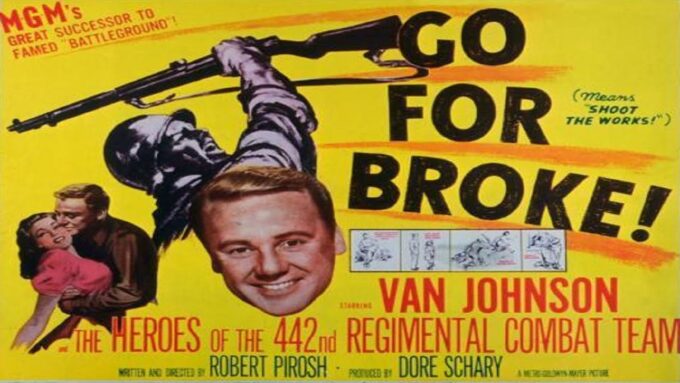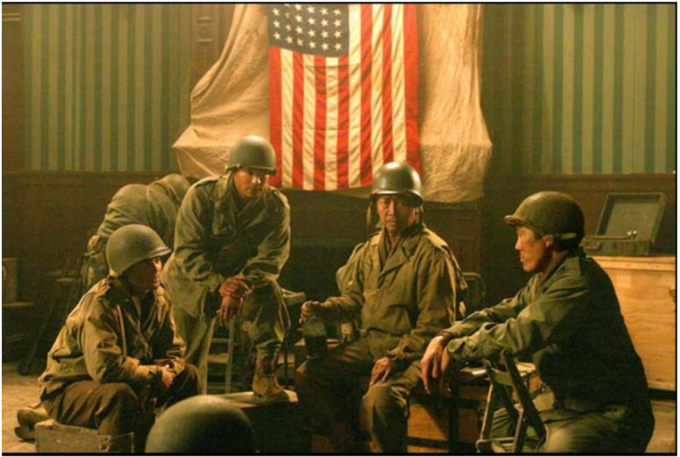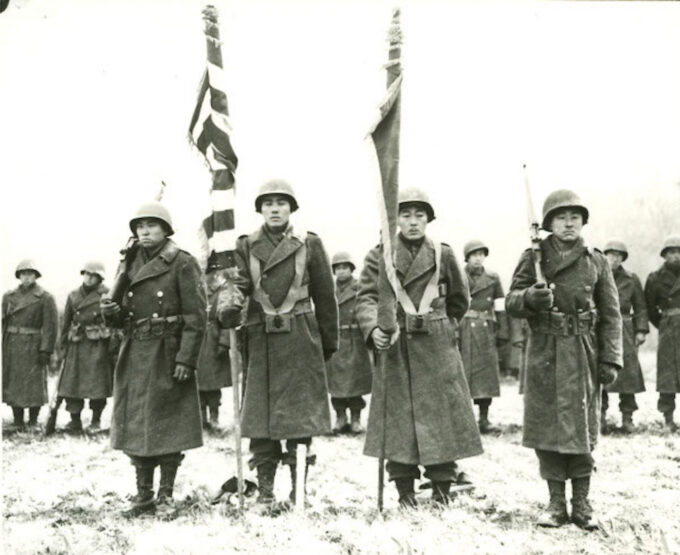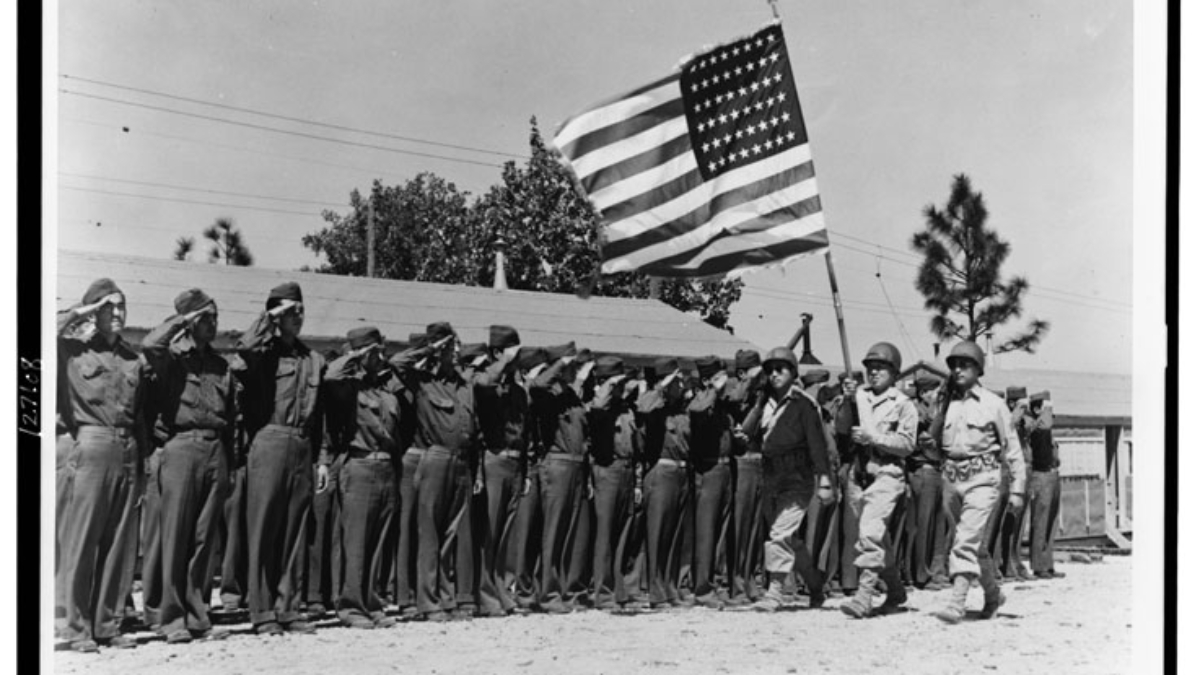Written By: Nathan Liu
The 442nd Regimental Combat Team; if you paid attention during history class at all, then you should be familiar with them. An all-Japanese American fighting unit that served in Europe during the Second World War, the 442 remains the most decorated group of its size in U.S. military history, with 21 Medals of Honor, eight Presidential Unit Citations, 4,000 Bronze Stars, and over 4,000 Purple Hearts. One of their companies helped liberate Dachau, and even saved survivors of a death march near Waakirchen. To put it in simpler terms, they were heroes. They fought harder, achieved more, and just as crucially, lost more than anyone else. And that was because they had to. Many enlisted straight from Incarceration Camps, hoping that their service would prove to the U.S. government that they were loyal, and that their families should be set free. And if the sheer number of awards and honors they received proves anything, I’d say they succeeded in both areas.
Despite their legendary status, however, there are shockingly few movies about them. There are documentaries, such as Joan Saffa and Wendy Hanamura’s “Honor Bound: A Personal Journey,” but when it comes to narrative feature films, not so much. Which is odd, since theirs is a story that practically comes pre-written. You’ve got the internal conflict of serving in the U.S. Army while your family is imprisoned. You’ve got tension with white soldiers, who think you’re the enemy. You’ve got the tragic irony of liberating other people from concentration camps, when you can’t do the same back home. And, of course, you have World War II, which we know Hollywood loves. All of this is incredibly cinematic. And yet to my knowledge, there are only two narrative features that directly address the 442’s experiences in battle: Robert Pirosh’s “Go For Broke” and Lane Nishikawa’s “Only The Brave.” The former is an MGM movie that’s now public domain, meaning the people who made it didn’t bother to copyright it, and the latter is a low-budget indie film written, directed and starring Japanese American playwright Lane Nishikawa. So you have one of the most fascinating and inspiring true stories of heroism in history, and yet there have only been two movies made about it? That’s not right.

“Go For Broke” is an odd movie. Released in 1951 and starring actual veterans of the 442 as essentially themselves, the flick is in many ways very, very familiar. You have a white POV character (played by Van Johnson) who is forced to interact with people of color (the 442), and grows to respect and even defend them. That’s a plot that’s been used and reused countless times in films like “Green Book,” “The Help,” “Dances With Wolves,” “The Last Samurai,” and “The Best of Enemies.” At the same time, the movie is remarkably progressive for the 1950s. It portrays Asian characters in a positive light, and gives them distinct personalities and quirks. There are tons of scenes where we see them talking and joking amongst themselves. We learn where each of them is from and what they like. And the film goes out of its way to show divisions and differences within the Japanese American community. Some are shown to speak fluent Japanese. Some are shown to not understand a word. Some are enlisted from inside Incarceration Camps. Some enlisted from places like Iowa and Texas, where they were “free men.” Some have regional accents, like the Nissei from Hawaii. Some don’t.
If anything, it’s moments like these, where the film goes out of its way to explain things that Asian American viewers would just instinctively know, that seriously date it. Take the title, “Go For Broke.” It was the 442’s motto, and derives from a Hawaiian Pidgin phrase, meaning “bet it all on one roll.” Most people nowadays have a general understanding of what this saying means, as it’s entered the public lexicon. But because this was a film made in the 1950s, and for a white audience who probably didn’t have any firsthand experience with Japanese American culture or history, there are a ton of scenes where characters sit Van Johnson down and explain that and other things to him. On top of that, the film’s language, violence and general tone are surprisingly tame, no doubt as a result of censorship.
This film was made during the time of the Hays Code, which enforced rigid moral standards in film, and forbade everything from interracial romance to “lustful kissing.” That’s why, despite the fact that this movie is a war film about a unit nicknamed “The Purple Heart Battalion” because of their high casualty rate, it has no blood, no swearing, and a surprising amount of goofy slapstick. All of this together makes the film feel like an after school special, which honestly might be the best way to look at it. After school specials are clearly well-intentioned, but don’t have the budget, acting, or writing to be effective in their messaging. And that’s what this film is — well intentioned, but clearly limited by censorship, on-the-nose dialogue and some pretty stiff acting. As cool as it is that the filmmakers cast the actual veterans of the 442, that doesn’t excuse the fact that some of these guys are pretty bad actors. I don’t blame them for being stiff — they’re soldiers, not performers — but there are some moments where it becomes a bit cringe-worthy. So, all in all, “Go For Broke” is a flawed, but deeply fascinating and clearly well-intentioned piece of American film history. I honestly would recommend watching it, if only to see real veterans of the 442 re-enacting their heroic deeds on the big screen.

“Only The Brave.”
“Only The Brave” is a very different story. In some ways, it’s an improvement on “Go For Broke” as, in addition to having a Japanese American writer/director and showing the war through Japanese American eyes, it actually features some recognizable actors. Pat Morita, aka Mr. Miyagi from “The Karate Kid,” Jason Scott Lee from “Dragon: The Bruce Lee Story” and Marc Decascos, aka The Chairman from “Iron Chef America,” all have supporting roles. There’s even more “Karate Kid” alumni, with Yuji Okumoto and Tamilyn Tomida, both of whom appeared in “The Karate Kid, Part 2” and “Cobra Kai”. So at least the line delivery is serviceable, since it’s being done by actual actors. In addition, the film is noticeably darker and more violent, having an R-rating and thankfully omitting “Go For Broke’s” goofy slapstick. Unfortunately, that’s about all this movie does better.
This is a low-budget film, in every sense. The costumes look like they were bought at a Halloween store. All the interiors look like a Home Depot Lane Nishikawa got permission to shoot in after hours, with the stipulation he couldn’t add too much furbishing. You never see more than ten people on screen at a time, because they clearly couldn’t afford to hire more extras. The score sounds like it was performed by one person on a Cassio keyboard. The cinematography is incredibly shaky and super tight during the fight scenes, no doubt as a means of hiding the fact that they couldn’t afford better effects. And the film also manages to somehow tell us too much, while also not telling us enough. For example, the film makes use of both voice over and text on screen to explain the characters’ back stories, no doubt because building an Incarceration Camp would have been expensive.
But what is easily this film’s biggest flaw is the fact that it’s boring, something which stems from it having an incredibly messy structure. It begins in the future, with Lane Nishikawa experiencing PTSD, then flashing back to the war, then continuously flashing back throughout the film to show various characters’ back stories. As such, the perspective and narrative trajectory feel unfocused. And while it’s good to show, not tell, us things, the glimpses into these characters’ lives are oftentimes thrown in towards the middle of the movie after we’ve been asked to care. If “Go For Broke” feels like an after school special admirably trying to tell a worthwhile narrative but limited by bad acting and writing, “Only The Brave” feels like a home movie made with friends in a backyard with the props found in a closet. And that’s a shame. This movie was a chance for Japanese Americans to tell their own story, to address the things that “Go For Broke” either ignored or couldn’t show. Unfortunately, it wound up failing to entertain, and to make up for what its predecessor lacked.

(Credit: United States Army Signal Corps).
After watching these films, I found myself feeling somewhat despondent. In the 70 plus years since the end of the Second World War, only two mediocre movies have been made showcasing the 442’s heroism. And with so few survivors left, I found myself fearing that they’d never see a film that truly did their heroic actions justice: A film with a big enough budget to show the full-scale of what they were up against, good enough acting to bring them and their comrades to life, and a focused, engaging narrative. I felt myself getting overcome with despair, until I remembered the time I’m living in …
This is a time when Asian American visibility is higher and Asian American stories are in greater demand. In 2021, we don’t have to worry about censoring language or violence. In 2021, studios don’t have to be convinced that movies made by, and starring, Asian Americans can make money. And most importantly, in 2021 we have the technology to fully realize the scope and horror of World War II on relatively small budgets. Clint Eastwood’s “Letters From Iwo Jima” was nominated for Best Picture, featured impressively staged battle sequences, and only cost $19 million to make. Imagine what a movie about the 442 could look like with that budget. Or imagine what it could look like if it had a budget on par with something like “Dunkirk” which cost over $100 million to produce. It’d be pretty spectacular.
So Hollywood, if you really want to tell Asian American stories, make a movie worthy of the 442’s heroism. Give a Japanese American filmmaker — someone like Hiro Murai, or Cary Joji Fukunaga — a huge budget and the chance to tell a focused, serious narrative that accurately portrays the struggles, suffering and triumphs of America’s most decorated military unit. They gave us their lives. The least we can do is give them a good movie.
“Go For Broke” is currently available on demand at PlutoTV. “Only the Brave” is currently available on demand via Amazon Prime Video.

